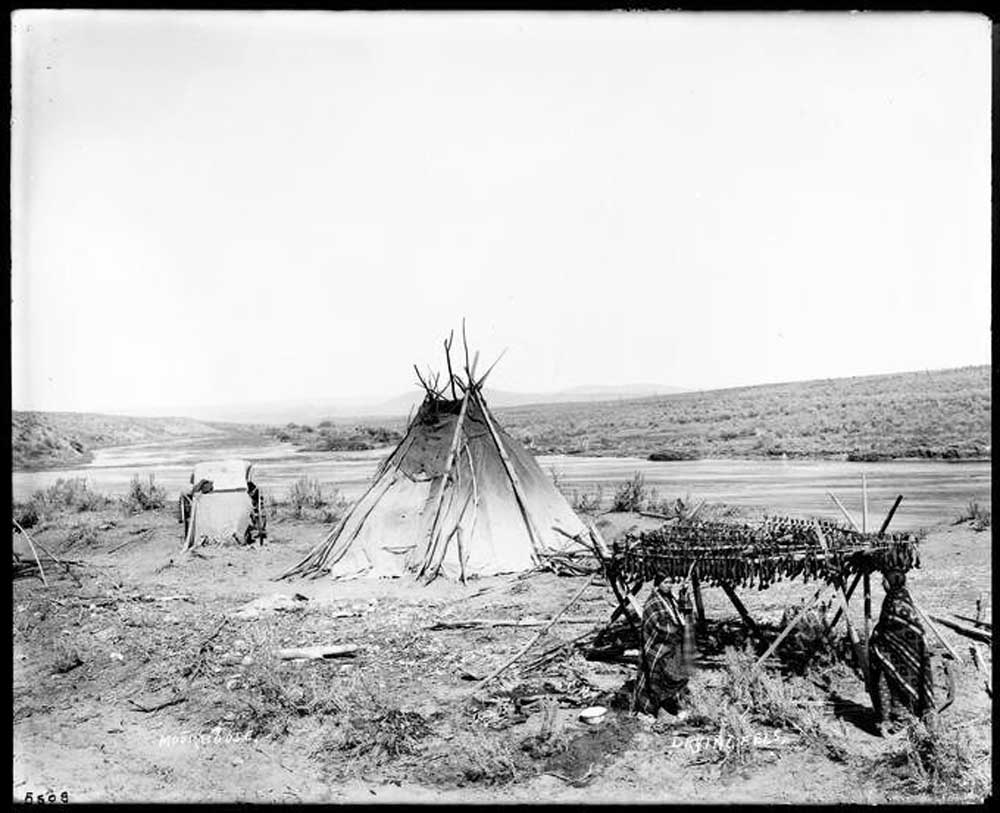The natural world: Return of the night eel
Published 3:00 am Saturday, June 4, 2022

- Billy Barnhart’s camp on a bluff above the lower Umatilla River, around 1903, showing “eels” drying on wooden poles.
It is a breezy day in late May and I am knee deep in the Umatilla River. Flows dropped enough following a recent surge of snowmelt and rainfall to allow for safe wading. Cliff swallows carve a graceful path through the air as they pick mothlike caddisflies from the water’s surface. The honey-sweet odor of wispy cottonwood bloom floods the air. Water cascading from upstream rapids masks the sound of nearby freeway traffic.
I stand still as a post where a patch of loose gravel has collected atop ancient lava flow and watch a pair of Pacific lamprey wriggle in gentle current. Named the “night eel” because of their nocturnal behavior and serpentine shape, lamprey lack the backbone of true eels that spawn in the Sargasso Sea. Without paired fins to maneuver and an air bladder to stay buoyant, they are more challenged than a ’49 Ford on a Los Angeles freeway. What lamprey do possess, though, is the ability to navigate rock-faced falls using their sucking mouth to grab hold and flexible tail to corkscrew up and over.
Adult lampreys migrate from the Pacific Ocean from May to September and “hold over” in mainstem reservoirs of the Columbia and Snake Rivers before spawning the following year. Their appearance in Blue Mountain streams coincides with the spring migration of chinook salmon, welcome bloom of arrowleaf balsamroot and the joyful song of meadowlark.
Both sexes of Pacific lamprey build a nest in sandy gravel via body vibrations and by moving small rocks with their mouth. After eggs hatch, the larvae or ammocoete burrow into the river bottom to feed on microscopic algae for 5 to 7 years. During this time, the juvenile form has an oral hood, lack teeth and eyes are underdeveloped.
Lampreys the size of a small garter snake emerge from their burrow and begin a lengthy, danger-fraught journey to the Pacific Ocean under the cover of spring freshets. Only after they transform to the young adult stage do they attach to other fish and suck body fluid and blood for nourishment.
Adult Pacific lamprey have no value to sport anglers (except for use as sturgeon bait). However, they are part of the food web for sea lion, white sturgeon and fish-eating birds. Similar to Pacific salmon, the spent carcasses of sea-going lamprey contribute ocean-derived nutrients to tributary streams.
Coincident with hydroelectric dam development in the Columbia River, numbers of adult lampreys migrating over Bonneville Dam declined from 350,000 in the 1960s to 22,000 in 1997. A similar pattern of decline was observed in the Snake River after completion of the Hells Canyon complex and the four lower Snake River dams in the 1960s. Loss of critical tributary habitat from poor irrigation practices, deforestation, grazing and treatment with rotenone to poison “trash fish” added to the toll. That juvenile lamprey are poor swimmers and have a bottom-dwelling lifestyle make them particularly vulnerable to introduced bass, walleye and channel catfish.
Regional Indian tribes and the U.S. Fish and Wildlife Service lead conservation efforts to restore runs of Pacific lamprey populations. Lampreys dried in the sun or roasted over wood coals are considered a delicacy by tribal elders. Translocation, or placing adult lamprey in Columbia Basin streams where populations were formerly present, has produced promising results in several streams, including the Umatilla, Yakima, Methow, Wenatchee and Clearwater rivers. In some cases, numbers of returning fish have been large enough to support a modest subsistence fishery for tribal members.
The anthropologist Eugene Hunn wrote how Sahaptin-speaking peoples from the mid-Columbia intercepted a spawning run of “eels” during a 19th century spring root-gathering excursion up the John Day River. At large falls such as Celilo and Kettle, migrating lampreys were collected off rocks where they attached to rest. A tradition of tribal harvest continues today at Oregon’s Willamette Falls.
The Wanapum Tribe tells of an important fishery near Pasco, Washington, a location referred to as Kosith or “at the point of land.” Adult lamprey congregated there, perhaps confused by flow from three adjacent rivers, and were caught at night from canoes by Indian fishers who used dip nets made of hemp. The flooded backwater of McNary Dam put a stop to that practice.
The Snake River near Asotin, Washington, was another traditional harvest location for Indian fishers. An 1892 report of the United States Fish Commission described the occurrence of this revered “three-toothed” lamprey as far upriver as Lower Salmon Falls. Nez Perce elders still share stories of catching “eels” as young children in the Clearwater River.
Dark clouds loom overhead. Behind me, on a shoreline lined with brush willow, a redwing blackbird struggles to balance on a branch that sways with each gust of wind. A thunderstorm is in the works. Three lamprey as long as my arm swim into the shallow riffle at my feet and join the party. One male grasps a female with his sucking mouth. Their bodies twist and intertwine. Eggs and milt mix their life energy with the river.
The ancient night eel has survived against all odds for thousands of years. Bearing witness to their return assures the circle of life is not broken.



